Middle Russian Future Periphrastic Constructions in the Light of Language Contacts
IF 0.2
0 HUMANITIES, MULTIDISCIPLINARY
引用次数: 0
Abstract
ABSTRACT This paper examines periphrastic constructions with future time reference in Middle Russian, focusing on constructions with an inchoative verb and an infinitive clause: počnu ‘begin’ + inf, načnu ‘begin’ + inf, imu ‘take > begin’ + inf, učnu ‘begin’+ inf, and stanu ‘rise > begin, become’+ inf. The author compares these periphrastic constructions and establishes that the verb učati ‘begin’ differed from the rest of the inchoatives (počati, načati, jati, stati) in that its distribution was functionally restricted and its derivational potential limited (i.e. no verbal nouns, participles, or imperfective verbs derived from this stem). On the 1 I am grateful to the two anonymous reviewers from Scando-Slavica, the editors of the volume for their valuable comments, and Dr. Katie Sykes for her professional English language editing. basis of these features, the author argues that učnu + inf emerged due to contact influence: specifically, the borrowing of a pattern from a Finno-Ugric language spoken in the eastern or northern part of the Grand Duchy of Moscow at the time. It is likely impossible to identify the construction which served as a source for učnu + inf. The author’s hypothesis is further supported by data from contemporary dialects and early attestations in official documents from eastern and northern areas.从语言接触看中古俄语的未来短句结构
摘要:本文考察了中古俄语中带有未来时间参照的周边结构,重点研究了带有起始动词和不定式从句的结构:počnu“begin” + inf,načnu“开始” + inf,imu’take > 开始' + inf,učnu“开始”+inf,stanu“崛起” > begin,变成'+inf。作者比较了这些外围结构,并确定动词učati'begin与其他起始词(počati,načati、jati、static)的不同之处在于,它的分布在功能上受到限制,其派生潜力也受到限制(即没有从这个词干派生的动词名词、分词或不完全动词)。关于1,我感谢《斯拉维察丑闻》的两位匿名审稿人,他们是该卷的编辑,他们的宝贵意见,以及Katie Sykes博士的专业英语编辑。基于这些特征,作者认为učnu + inf的出现是由于接触的影响:特别是借用了当时莫斯科大公国东部或北部所说的芬诺-乌戈尔语的模式。很可能无法确定作为učnu来源的建筑 + 作者的假设得到了来自当代方言的数据和东部和北部地区官方文件中的早期证明的进一步支持。
本文章由计算机程序翻译,如有差异,请以英文原文为准。
求助全文
约1分钟内获得全文
求助全文

 求助内容:
求助内容: 应助结果提醒方式:
应助结果提醒方式:


